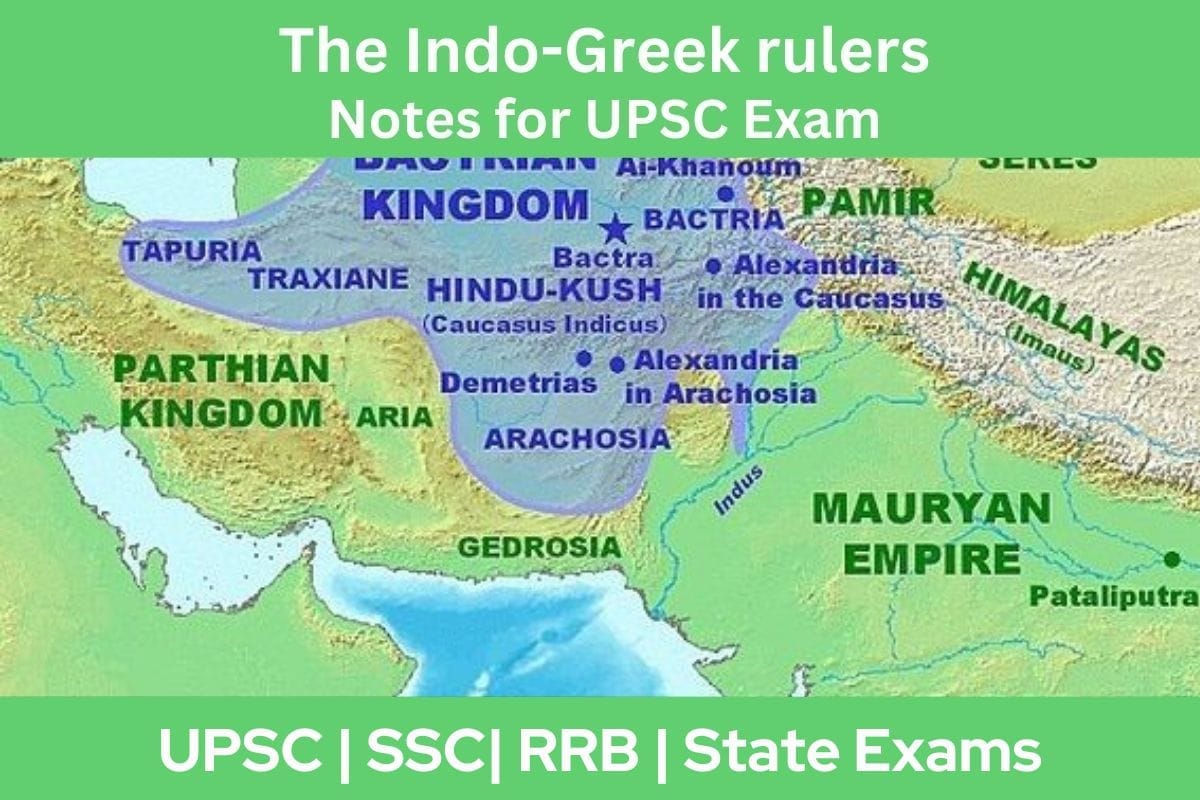
Indo-Greeks
- Around 200 BC, the Indo-Greeks made their first moves across the Hindu Kush in a series of invasions.
- The Greeks took charge of Bactria, the region just south of the Oxus River in northern Afghanistan.
- In the early 2nd Century BCE, these Bactrian Greeks moved south of the Hindu Kush, and this bunch became known as the Indo-Greeks.
- The Yavana kingdom is historically called the Indo-Greek Kingdom too.
Who Were The Indo-Greeks?
- The Indo-Greek civilization came about from the meeting of the Indian subcontinent and the Greek kingdoms after Alexander the Great’s conquests.
- The rule of the Indo-Greeks in India is a significant part of Ancient History.
- Well, it points to a time in history when Greek kingdoms mixed it up with the Indian subcontinent.
- Picture this: Greek rulers and their descendants set up shop, making their mark in the northwestern parts of India. That includes today’s Afghanistan, Pakistan, and the northern bits of India.
Here’s a quick rundown: After the Mauryas took a backseat, northern India turned into a bunch of separate kingdoms. Come 185 BC, the Sungas took charge in the Magadha region. But hold on, the northwest of India had its hands full with attacks from the northwest and Central Asia. Fast forward to around 180 BC, and bam, the Indo-Greek kingdom came to be. King Demetrius led the charge, marching into the Indian subcontinent.
Indo-Greek Invasion
The Indo-Greek invasion marked a crucial moment in the histories of both regions, bringing Greek influence into the Indian subcontinent. The key reasons behind these invasions were:
- The Seleucid empire in the area was weak, making it vulnerable to multiple invasions.
- Rising pressure from the Scythians weakened Greek control in Iran and Parthia.
- The construction of the Great Wall of China halted Scythian advancement, redirecting their attention and causing Bactrian Greeks to enter the region.
Important Indo-Greek Rulers
Now, let’s talk about some renowned Indo-Greek rulers:
- The Bactrian Greeks, also known as Indo-Greeks, were the first invaders. Their rule extended even beyond Alexander’s, covering parts of north-western India up to Ayodhya and Pataliputra.
- Menander, the most famous Indo-Greek ruler, reigned for two decades, from 165 BC to 145 BC. Also known as Milinda, he made Sakala (modern Sialkot in Punjab) his capital and invaded Ganga-Yamuna Doab.
- Menander embraced Buddhism, guided by Nagarjuna, also known as Nagasena, who answered his numerous queries in the book “Milinda Panho” or “The Questions of Milinda.”
Coinage
Let’s shift our focus to coins during the Indo-Greek rule:
- In the north of the Hindu Kush, gold, silver, copper, and nickel coins with Greek inscriptions were used.
- These coins depicted Greek deities. In the south, silver and copper coins, mostly square-shaped, adhered to Indian weight standards with bilingual inscriptions.
Impact Of Indo-Greek Invasion
Why does Indo-Greek rule matter? It left a lasting impact on polity, trade, religion, art & culture, and technology:
- Greeks introduced Military Governorship, known as Strategos, which persisted in various forms until the Mughal era.
- Military Governorship provided foreign rulers with a means to control conquered territories and people.
- The Indo-Greeks left their mark on trade, making a big splash with the introduction of coins, a first by kings in the country.
- They even pioneered the use of gold coins, a trend later picked up by the Kushans.
In 47 AD, a Greek sailor named Hippalus discovered the Monsoon sea route from West Asia to India, giving trade a significant boost. This discovery also led to the establishment of crucial ports like Barygaza (Bharuch) and Barbairicum on the Western Coast, as well as Arikamedu (Podeku, as per Periplus) on the East Coast.
Impact On Religion
Now, let’s talk about the impact on religion.
- The Indo-Greeks brought Hellenistic art, blending it with Indian art, birthing the Gandhara school of art. Foreign rulers actively supported Indian art and literature, resulting in the creation of Buddha images in a Graeco-Roman style.
- Three notable schools, Gandhar School (50 BC to 5th Century AD), Mathura School (150 AD to 300 AD), and Amravati School (150 BC to 400 AD), emerged during this time.
Technological Impact
- In terms of technology, the Indo-Greeks played a role in developing Astrology in the country. Greek terms found their way into Indian Sanskrit texts discussing planet movements.
- While India already excelled in medicine, botany, and chemistry through figures like Charaka and Sushruta, the Greeks didn’t contribute much in these areas.
Decline Of Indo-Greeks
- As for the decline of Indo-Greek rule, the last king, Strato II, ruled the Punjab region until 55 BC, or some argue until 10 AD.
- The Indo-Greek era concluded with the invasions of Indo-Scythians (Sakas). The Saka Dynasty, Parthians, and Kushana rulers took over larger territories than the Greeks.
- Interestingly, instead of fading away, the Indo-Greek kingdoms became part of the country. The rise of the Gupta empire around the 4th Century AD officially marked the end of both native and foreign princes’ small empires.







